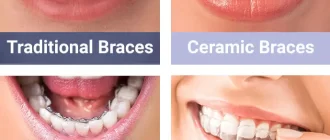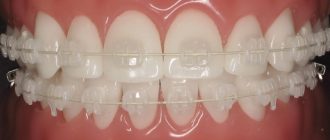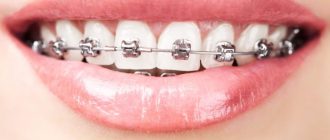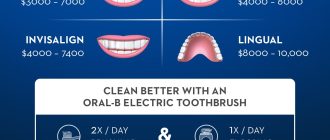Many people with crooked or overcrowded teeth or those who have overbite or underbite consider teeth straightening procedures. A frequently asked question is whether it’s worthwhile using standard braces or Invisalign to correct the problem. These two options are commonly explored by adults who wish to hide the fact that they have braces and make the process more inconspicuous. The cost difference between the two can be an influential factor determining the choice one way or the other.
What is the cost of Braces?
Standard wire braces can come in different forms such as metal, ceramic, colored and even behind the teeth. The cheapest form is the traditional metal braces which can be purchased for as low as $3,000 but can also cost around $8,000 depending on how crooked the teeth are and how long the treatment needs to be in place. Many people find this is a low-cost way of straightening their teeth, however in some situations Invisalign can be more cost effective.
What is the Cost of Invisalign?
Invisalign is a product manufactured by Align Technology. They are clear plastic aligners which are removable and do not stand out as much as fixed braces. Standard treatment involves getting updated molds approximately every two weeks. However the treatment process can be a lot quicker than for traditional braces. The average cost for Invisalign is approximately $3,500 to $9,000. Once again the cost will depend on the area that you live in and the extent of treatment required.
Many consider Invisalign as the optimal realignment option since it offers benefits over traditional braces. The most obvious benefit is that the clear aligners provide a more aesthetically pleasing look as opposed to the metal or even ceramic wired bracket braces. Another benefit of Invisalign is that since they are removable, they and the teeth can be cleaned more thoroughly which minimizes demineralization or tooth decay.
Invisalign also is less likely to cause root resorption (where the roots of the teeth shorten due to braces treatment).Also Invisalign enables more accurate x-rays to be taken since the aligners are able to be temporarily removed from the teeth. All these factors need to be considered when comparing the cost of braces as opposed to Invisalign since demineralization and root shortening can cause problems and therefore additional dental expenses in the future.
When is the Cost of Braces Cheaper than Invisalign?
Even though braces must be applied by a qualified orthodontist, they can still end up being cheaper than Invisalign treatment performed by a regular dentist. Braces are typically cheaper than Invisalign in any event. However, Invisalign can also involve in additional charges in some situations. One of these occasions can be seen where after the Invisalign process, the patient is not satisfied with the way the teeth have set. Since Invisalign can only treat minor or mild malocclusion, the end result may not be suited to the patient and may require further realignment with standard bracket braces. When this process is required at the end of the Invisalign treatment, this can add additional fees and charges to the overall orthodontic treatment with Invisalign.
Other situations where Invisalign can end up costing more than standard braces is because the aligners can be lost or misplaced, since they need to be removed during teeth cleaning, eating and drinking substances other than water. When the patient loses an Invisalign aligner, even though they are given two containers to place the aligners in (making it less likely), they will need to purchase a replacement aligner for that treatment stage, adding additional prices to the overall treatment process. Invisalign aligners may also be damaged during sleep or teeth grinding, also requiring replacement aligners. Although this is a rare occurrence, it can add further costs which you may need to budget for in your estimate.
Additional costs and treatment time may also be required with Invisalign where the patient does not keep the aligners on the teeth for the required length of time. Where this occurs, the treatment process goes off course and is extended. A new set of impressions and aligners will be required in addition to extra visits, which will all add to the cost of Invisalign. Taking these considerations into account, Invisalign may end up costing more in the end than traditional braces, even where the procedure is performed by a dentist rather than an orthodontist.
If Invisalign treatment requires buttons or attachments to be bonded to the teeth (for proper rotation), then this may also add to the total cost of treatment. However, you should be advised of this before you begin your Invisalign program.
When is the Cost of Braces More Expensive than Invisalign?
Invisalign treatment typically costs more than braces. However there may be situations where braces can end up being more expensive for the patient than by using Invisalign. The first aspect which adds cost to braces is that they must be performed by an orthodontist. Comparatively, Invisalign can be a treatment which is done by a dentist, who often charges less than an orthodontist since they have less training with teeth straightening. Even though orthodontists normally charge more for braces, it will depend on doctor’s skill, experience and location as to the overall price that is charged.
Braces can end up costing more than Invisalign where there are problems with the treatment such as root resorption or tooth decay. This occurs in up to 50% of patients and may add further costs to braces treatment. Invisalign typically avoids these problems and therefore may turn out costing less than traditional braces treatment.
Also the ability to clean the teeth thoroughly with Invisalign can reduce teeth staining and other problems such as gingivitis, which would add periodontic charges to the cost of braces treatment. Since Invisalign does not require a sephalometric radiograph, the costs of obtaining this x-ray are also saved with Invisalign treatment. However, orthodontists use these radiographs in order to determine the final position of the teeth and accordingly it may end up being more valuable to have braces treatment by a professional orthodontist as opposed to Invisalign with a dentist.
Additionally, the teeth straightening process with Invisalign is usually shorter than using braces. Invisalign patients finish their treatment approximately 4 months sooner on average than with fixed braces. Treatment time does add to the cost and accordingly braces can result in being more expensive since the time required to treat your malocclusion is longer with traditional braces.
There is also an Invisalign express program which takes around 20 weeks and is used to treat minor crowding or minor spacing problems. The cost of this program can be less than braces in the end.
When comparing braces and Invisalign, there can be numerous factors which affect the bottom line and overall cost. The best way is to speak to your dentist about the most cost effective method suitable to your situation as each patient must be assessed on a case by case basis. You need to be aware that Invisalign does impose a condition on dentists to start a minimum number of Invisalign treatments per year and accordingly your dentist may push you towards choosing Invisalign instead of traditional braces even if it’s on a cost saving basis rather than what’s better for your teeth. If you have any concerns about your dentist’s advice, seek a second opinion from a qualified orthodontist who is experienced in both braces and Invisalign and is able to provide you with a thorough quote for both procedures.






